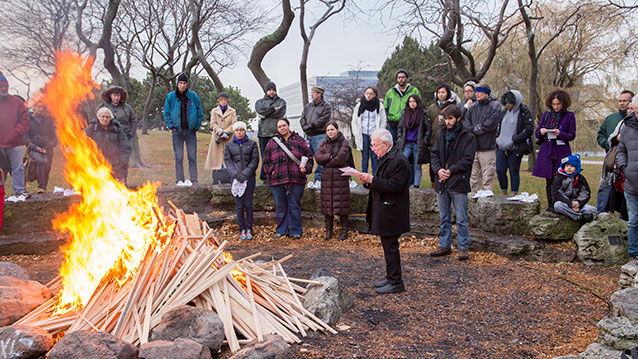EVANSTON, Ill. --- A steady traditional drumbeat echoed beneath the Weber Arch, where Northwestern University students gathered with Native Americans Saturday (Nov. 22) to remember the women, children and elderly men slain in the Sand Creek Massacre in 1864 in Colorado.
Just days before the 150th anniversary of the attack, nearly 100 people attended a commemoration at Northwestern for the victims of the massacre -- one of several events organized by the University’s Native American and Indigenous Student Alliance in honor of Native American Heritage Month.
The campus remembrance followed the release of recommendations by the Northwestern Native American Outreach and Inclusion Task Force on Nov. 17 to strengthen the University’s relationship with Native American communities through recruitment efforts, academic programs and campus support services.
“We’re hoping that this solemn occasion brings greater understanding of the devastation that occurred at the Sand Creek massacre while at the same time it gives voice to the Native Americans who have been silenced for so long,” said Patricia Telles-Irvin, vice president for student affairs and co-chair of the task force, who attended the commemoration.
Those gathering for Saturday’s vigil came to mourn the tragic loss of life and also look to the future. Speakers, some in tears, emotionally recalled the details of the attack by several hundred U.S. soldiers on an encampment of sleeping Cheyenne and Arapaho Indians.
“It is the blood of the holy ones that is the seed of the generations to come,” said Father Peter Powell, an honorary Cheyenne chief and spiritual director of St. Augustine’s Center for American Indians in Chicago.
“At Sand Creek there was this terrible outpouring of blood,” said Powell, asserting that the victims did not die in vain. “The Native American community … and Northwestern University made it possible to commemorate that outpouring of blood that gave life to or people.”
The massacre, in which U.S. Army Cavalry soldiers slaughtered approximately 150 Cheyenne and Arapaho, most of them women and children, occurred Nov. 29, 1864, when John Evans, one of Northwestern University’s founders, was the governor and superintendent of Indian Affairs of the Colorado Territory. Evans was later forced to resign in its aftermath.
In 2013, Northwestern Provost Daniel Linzer appointed a committee of eight senior scholars, four from within Northwestern and four from outside the University, to examine Evans’ role in the massacre.
On May 29, the John Evans Study Committee released an extensive report finding no known evidence indicating that Evans helped plan the Sand Creek Massacre or had any knowledge of it in advance. The report also criticized Evans for his failure to condemn the massacre after it occurred.
Subsequently, a second group, the Native American Outreach and Inclusion Task Force, was charged with recommending strategies to strengthen Northwestern’s relationship with Native American communities and to discuss Native American studies programs and support services for Native American students.
The recommendations have been sent to President Morton Schapiro and Provost Linzer, who will review them carefully before making decisions on how to proceed.
The commemoration Saturday began with a prayer, offered by Powell, and a traditional performance by an intertribal drum group called RedLine Singers. Then the group walked together to Harris Hall to hear speakers and finally on to the Fire Pit overlooking Lake Michigan.
\"We're all here to heal,\" said Jordan Gurneau, a 25-year-old member of the Ojibwe Tribe and one of six male members of the drum group.
Gurneau’s wife, Kitty, a 2010 Northwestern graduate, spent one night last week on campus with a group of student volunteers. In preparation for the event, they crafted 200 pairs of moccasins to represent the victims of Sand Creek.
On Saturday, the brightly colored canvas cutouts lined the walkway past the Weber Arch as tangible reminders of the individual lives lost.
In spite of inclement weather, Native American community leaders from around Chicago made the trip to the Evanston campus for the special day.
\"I think it's appropriate today that it's raining. It helps to hide our tears, but it doesn’t hide our heartbreak,\" said Vincent Romero, a Navajo Indian, veteran and the day’s Eagle Staff carrier.
“It is an emotional time for us to remember what happened,” said Andrew Johnson, a Cherokee and executive director of the American Indian Center.
The commemoration concluded with a bonfire on the lakefront.


